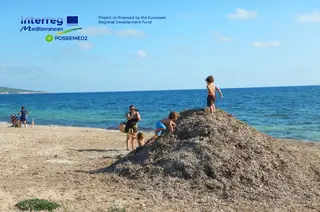The Mediterranean Sea
With 21 riparian countries, the Mediterranean Sea covers about 2.5 million km2, of which about 25% are under the full jurisdiction of the countries, the remaining part being potentially their exclusive economic zones when declared and agreed upon.
This semi-enclosed sea, open to the Atlantic by the Gibraltar Strait (14km width) to the Red Sea by the Suez Canal and to the Black Sea by the Marmara Sea, has for millennia been occupied by human and subject to multiple activities, reaching a critical level (a population of 150 million, plus 200 million tourists every year, freshwater overexploitation, overfishing, pollution, hazardous maritime traffic, exotic species, increasing coastal development), without considering the effects of climate and global changes.
In term of conservation, the Mediterranean marine biodiversity includes numerous endemic and some emblematic species of global conservation concern, but is still far from reaching the Aichi target 11 of 10% area coverage and properly managed marine protected areas (MPAs), half the way having being done in the past 50 years.
The IUCN Mediterranean Marine Programme is involved in a number of pragmatic initiatives to preserve and restore the biological integrity of the Mediterranean Sea, as well as to foster the sustainable development of the region. Our objective is to provide scientific knowledge and evidence for influencing national and regional decision-makers.
Mediterranean governance
Enhance cooperation and coordination between all Mediterranean stakeholders in order to influence governance and institutional processes for effective conservation and sustainable management of Mediterranean biodiversity and natural resources.
- Legislations and institutions for marine conservation
- Human activities management (fisheries, maritime traffic, etc.)
- Capacity building and dissemination of information
- Mediterranean Marine Conservation (strategies, declaration, management, monitoring, evaluation)
- To mitigate threats and impacts, through key tools for conservation and sustainable use such as regulations and spatial planning.
Mediterranean Marine Conservation (strategies, declaration, management, monitoring, evaluation)
To mitigate threats and impacts, through key tools for conservation and sustainable use such as regulations and spatial planning.
- Marine protected areas
- Marine conservation areas
- Marine managed areas
- Economic value of marine environment
- Integrated Coastal Zone Management and Marine Spatial Planning
Mediterranean marine species, biodiversity, ecosystems and habitats (strategies, action plans, monitoring)
- Red list of species
- Red list of ecosystems
- Deep Sea structures
- Exotic and invasive species
- Adaptation to climate change
- Helping marine biodiversity and people to adapt to climate change and propose measures to increase resilience of marine socio-ecosystems.
IUCN-Med is looking for PARTNERSHIPS to build alliances, fund and implement projects to:
- Reduce the impact of fisheries on vulnerable species and ecosystems
- Develop Conservation plans for imperiled marine (sharks, rays, corals), and terrestrial (raptors) species
For those interested, please send a message to MariadelMar.OTERO@iucn.org with the subject line: Partnerships for Marine or Blue Economy.





